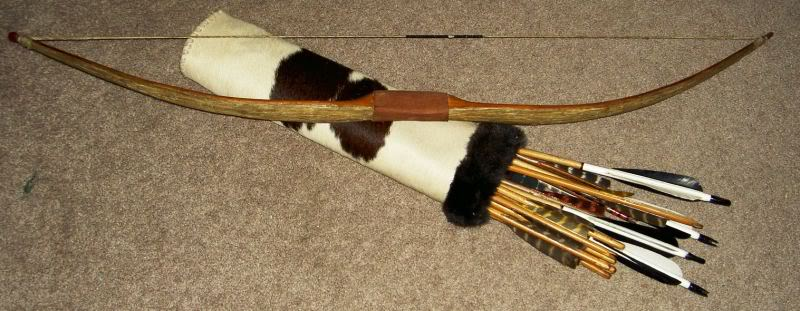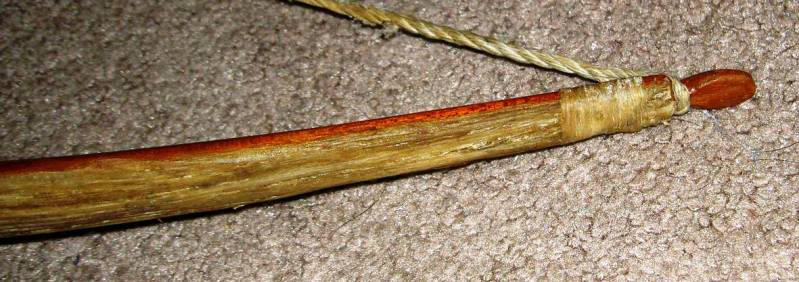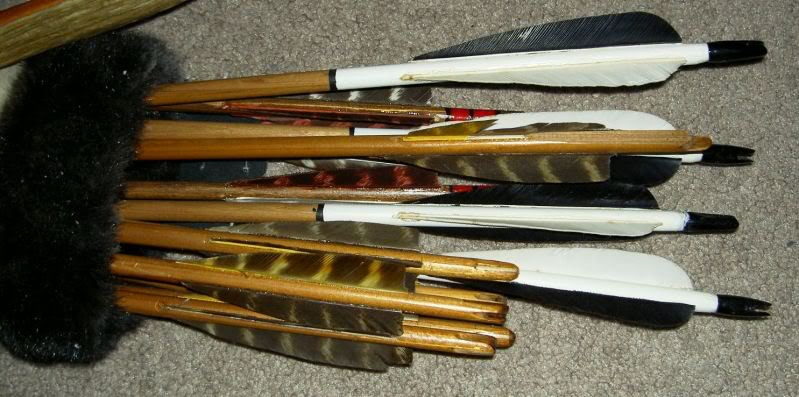Traditional Bow Making with Theodore Vandervelde
Theodore [Ted] Vandervelde passed away on July 22nd of 2009, but he left behind decades worth of traditional bow making. His bows are now collectors items.
The Muskegon, Michigan bowyer was interviewed years ago by the Examiner before his death and the following is excerpted from that interview - along with photos showing examples of both Ted's bows and also his quivers and arrows. Ted was exceptionally passionate about bow making, archery and promoting the sport of archery.

What got you interested in traditional bows?
I have always been interested traditional bows and archery. I had an (INDIAN) bow when I was about 9 years old, that is 64 years ago, and it was made by an Indian. I have always been interested in INDIANS and their culture. I tried to copy that bow and made a few pretty good ones. That little Indian bow was made out of cherry and I made mine out of sassafras knew very little about curing wood then but I made most of them from dead wood any way so it didnít matter. I have had a few compound bows over the years but never liked them, you canít snap shoot with them and they were heavy and noisy. To me they were just never a real bow, they still arenít.
What parts of the bows are made from game animals?
I have made bows out of different wood but Osage is my favorite. If you make bows out of most other wood other than hickory you should back them with something or donít shoot them too much. You can back a bow with a lot of different things. I have backed them with raw hide and sinew and fiber glass. If you stay with the real primitive way, which I prefer, you use sinew made from the tendons from deer or any other animal that will give long enough sinew. I am not as fond of raw hide but it will keep a bow from breaking and I have used both on the same bow. If I make anything over 60 inches long I donít back them at all. I have a bow that is 52 inches long that will shoot a 27 inch arrow and is backed with sinew, two layers and is 52# pull.

Above is an upclose picture of a bow made by Ted, backed with, and the tip supported with sinew from Whitetailed deer.
Can you outline the process of making one?
First you will need the proper tools.#1 A good sharp draw knife-#2 A flat spokeshave #3 A good rough half round file-#4 A good cabinet scraper.
First you have to remove the bark, if you buy a stave you may not have to. The bark side is always the back of the bow. You have to put this in a vice or on a shaving horse. If you have good wide grain the job will be a lot easier.
Place the bow in the vice or on the shaving horse, with the back of the stave up. Look at the end of the stave and find a good layer of grain to follow, you want the dark grain layer. Pick the best one closest to the back. Then take the draw knife and start removing material, starting at the end of the stave, and work towards the middle. You have to follow one grain layer the full length of the bow, if you cut through that layer and donít intend to back it, start over and pick another layer that looks good. If the grain is tight, this is much harder to do.
Take it slow and easy, DO NOT HURRY.
Once you have the back done, do not touch it again. The rest of the work and wood will be removed from the belly.
When working the back of the bow the lighter colored grain is gritty and sounds like sand when you cut it, so if you listen to the wood, it will tell you that under that sound is the layer you are looking for. Sometimes a light behind you will show you the different layers. If you have bought a stave your work will be a lot less, because it will already be reasonably true not at all like split stave, the belly should already be flat. With the stave firmly locked in the vice or on the shaving horse, the fun starts.
Mark the center of the stave and two inches on either side of the middle, this will be the riser or where you grip the bow. Start at one end and remove material and work toward the center, stopping at the two inch mark. You keep doing this until the limb is tapered, about one half inch thick at the knock and tapered up to the riser. While doing this be very careful not to make this wavy it should be a smooth taper. Now do the same on the other limb.
How difficult is it to get all of the authentic materials to make a bow?
To get all the materials to make a bow is really not too difficult. The draw shaves and spoke shave and scraper can all be purchased at a good hardware outlet or at a flea market. The stave can be purchased from a boyer or cut down, if you have access to the trees. If you cut your own you have to season the wood before making a bow. The only problem is the tools made today donít match the old tools for quality your best bet is the flea market, just be careful what you buy, even there try to get the best quality you can but they can be expensive.

Above is examples of arrows, all hand made by Ted, including turkey feather fletching on some. The quiver was also hand made and covered with cow hide, bow and string hand made.
How many different styles or methods of bow making do you use? Can you describe how they differ form one another?
I prefer the long bow but I have made recurves as well. I have bows from 52 inches in length to 72 inches in length.
I like to stick to the old way of making bows but I have a couple of really nice laminated bows, one with 72 inch radiuses in the limbs and one 68 inch long bow. I have a few that I made my own laminations for.
I have three take down bows where the limbs are attached to the riser and I have a few that take apart at the riser, The sleeves for this can be purchased from an archery catalogue, I prefer to make my own. I have made a couple that were hinged in the riser and could be taken down. I have an oven that I built to make the laminated bow and I have various bow forms for doing this that I made. There are all kinds of books and information out there on this subject if you know where to look. I am sure a lot of this information can be found on the internet.
What are the draw weights of some of these bows?
I have bows from 32# to 60# I used to shoot heavy bows when I was younger now I prefer them in the 40# to 55# range ,they are a lot easer to shoot and you donít have to strain to do it.
I donít sell these bows and have only given a few away. Some of them broke trying different things with them and these I took the limbs and made crossbows out of them, you learn by trying different things but this can cost you a nice bow if things donít go right. Or you end up with a lot of crossbows or kindling.
Have you taken game with them or anyone else with the bows you have made?
I have deer hunted with these bows but going out with a stick and a string the deer win.
I have never gotten one although I have hit a couple and blood trailed until we ran out of sign.
My grand son got one with a bow I made.
Can you describe the arrow making process in a little bit more detail?
Complete books have been written on this subject, because of all the different ways of shooting today and all the different equipment used today. In simple terms you need a shaft-feathers- knock-head and a fletching jig to attach the feathers to the shaft. You need a tapering tool to taper the knocked end of the shaft and the end where the head goes, both require a different taper. Put the knock taper on first and glue the knock on. Then fit this in the fletching jig and put the cock feather on first 90 degrees from the slot in the knock, so when the arrow is on the string the cock feather will be on the left side of the arrow. Then put on the next feather by turning the adjusting knob one klick, repeat this for the third feather, then put the head on if you have the arrow the proper length. You can purchase a fletching jig that will put all three feathers on at the same time. You can dip the shaft in paint, shellac or Polly urethane or whatever you prefer except oil. A cresting jig can be purchased to put a crest on the arrow or do it free hand.
How about the string making process?
You can make a bow string with very little else except the material you intend to use.
Jigs to make bow strings can be purchased from most good archery magazines. You can take a board about three feet long and put two nails in it spaced about 14" longer than the bow and rap it five times with B-50 Dacron bow string material. Remove this from the nails and wax it good. Do this three times so you have three bundles of five strings. You twist and weave seven inches of the end to form a loop to fit over the knock, do this on both ends; this is the purpose of it being 14" longer than your bow. Then you serve the part where the arrow will be on the string to fit the arrow knock and keep it from fraying when shot. If the string is to long for the bow, hang it from a nail with some weight holding it down and twist it, this will make it shorter. To really explain the process of string making, you could write a book--ok.
What is a good source of information for some one looking to get into making bows?
You can subscribe to Traditional Archery or Primitive Archery or any good archery catalogue and find this information. There are a lot of books out there that you can buy and you can find this on the internet also. I personally think two of the best books are Cherokee Bows and Arrows buy Al Herrin and The Bent Stick by Paul Comstock. Al Herrins book will teach you the old way and deals with Osage orange, Paul Comstock deals with all different wood species and goes in to great detail. Get either of these books and you can make a bow, there are other books you can get off the internet. .
Are there any practical advantages to using a traditional bow?
I donít think there are any real practical advantages to using a primitive bow. If you are out for meat and thatís why you go hunting, use a compound bow. They shoot like a rifle and you donít need much practice but if you want a real challenge and love the real sport of hunting then use a primitive bow. The deer definitely have the edge; it gives you a real appreciation for the Indian.
Compound bows have taken over because the younger generation is in to technology and like the fact they donít have to practice as long to be good at it. Almost any one can shoot a compound with very little practice, not so with a stick and a string and no sights to line up. To me this is not archery at all, I guess Iím too old and set in my ways.

